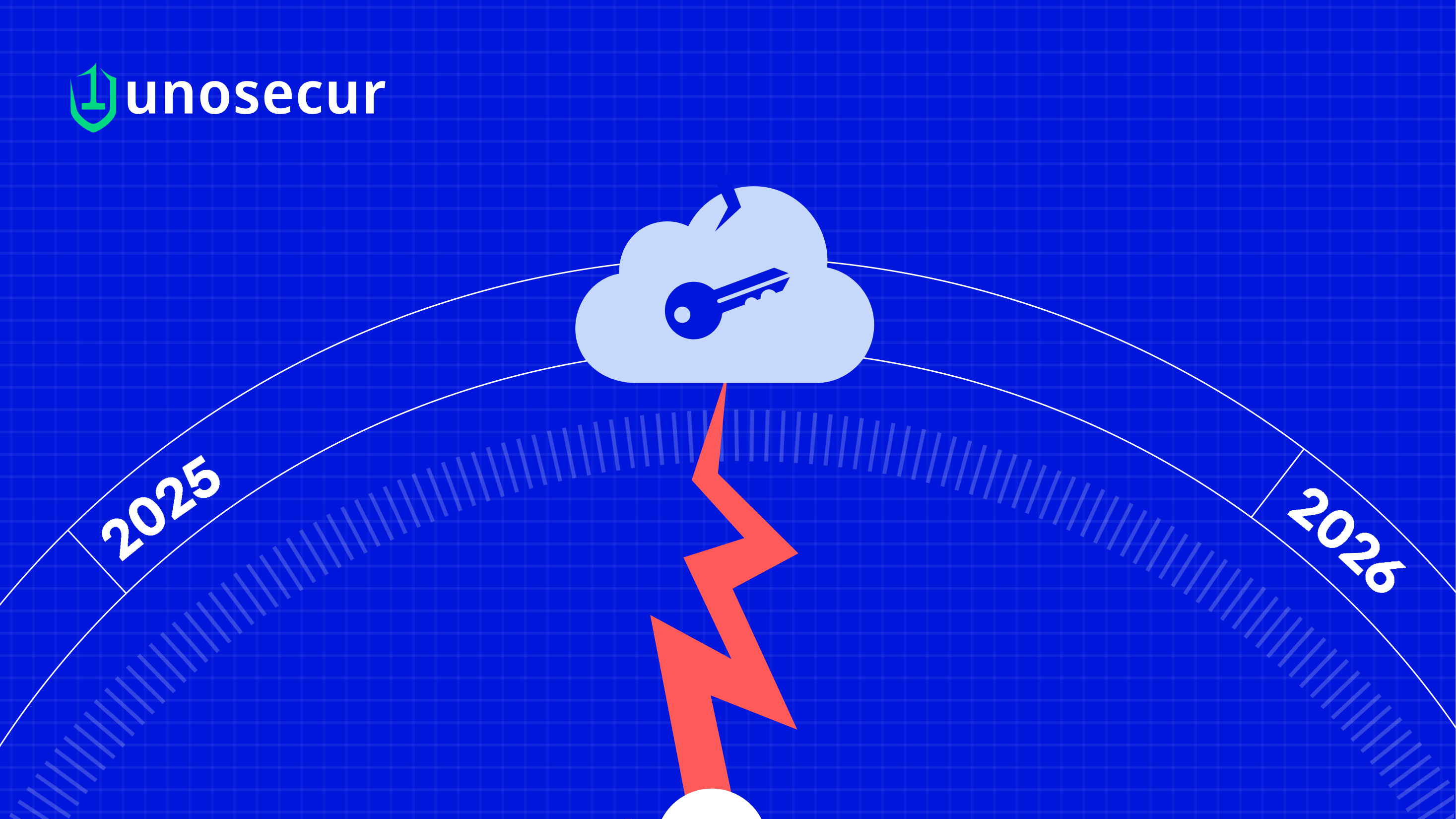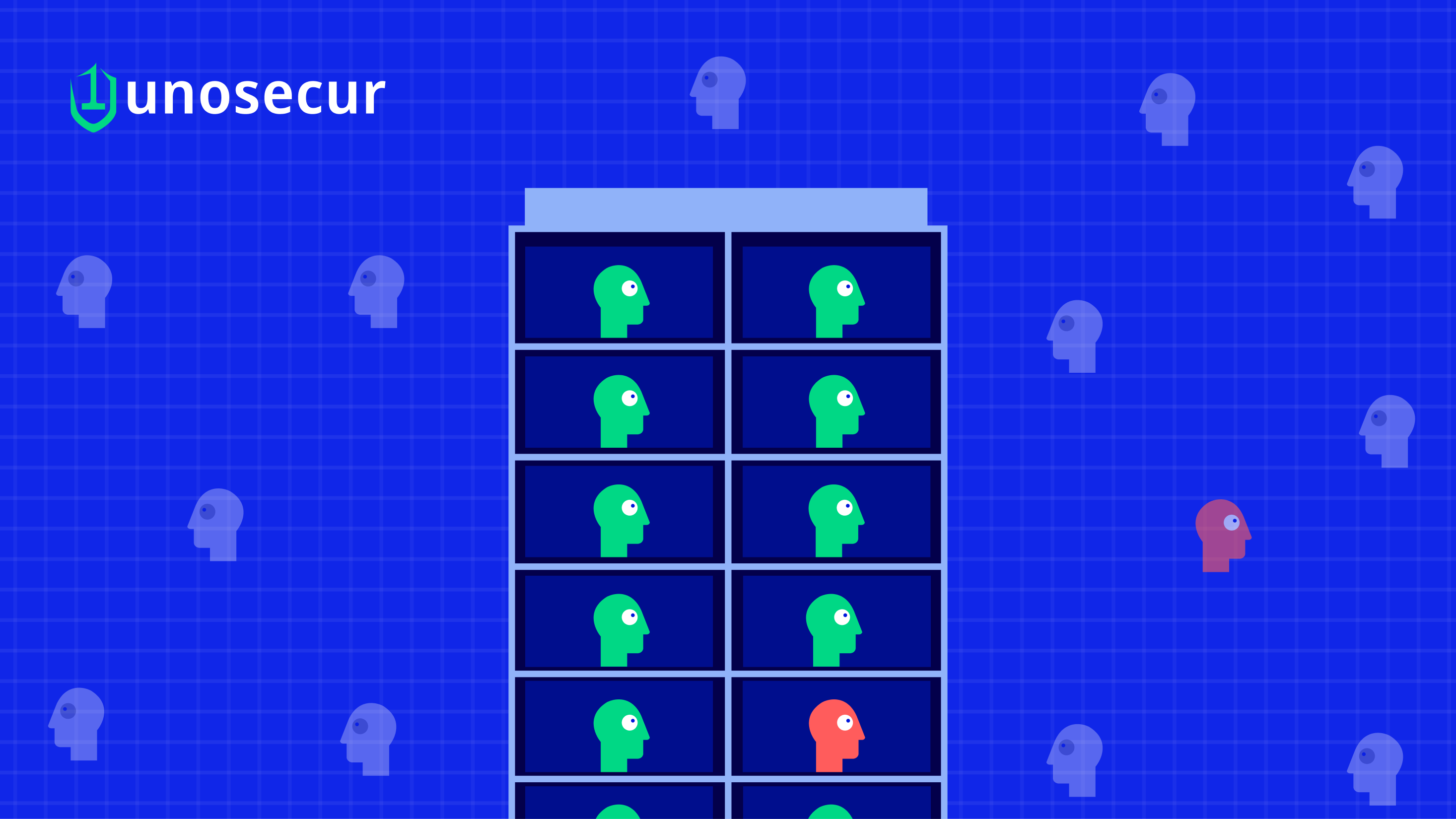Identity vs credentials: A manager’s guide to protecting every identity

In the six month period from January 1, 2025, Unosecur did security posture assessments for 169 organizations across different sectors and geographies. One of the top common questions asked by managers in the post-assessment meeting was this: are identities and credentials the same?
Spoiler: they’re not. Confusing them invites breaches.
This guide walks through what credentials really are, how they differ from identity, the chaos that follows when the two are confused, and how forward-looking organizations keep log-ins both effortless and ironclad.
Identity vs credentials - TL;DR
Are credentials and identity the same thing?
No. Identity is the permanent record; credentials are the proof presented at login.
What happens if a credential is stolen?
A2. You can revoke the credential without deleting the underlying identity, limiting damage.
How does Unosecur improve identity security?
A3. By discovering every credential, checking its posture, and responding in real time when anomalies hit.
What exactly are credentials in cybersecurity?
Credentials in the cybersecurity context refer to any information, data structure, or object used to verify the identity of a user, system, or service and grant access to digital resources or systems.
They serve as the "keys" that allow authorized individuals or processes to access sensitive information, networks, or applications, and are fundamental to maintaining security and access control in digital environments.
Common credentials types
- Usernames and passwords: The most widely used form of credentials, where a unique identifier (username) is paired with a secret (password) to authenticate a user.
- Tokens: Physical or software-based devices that generate codes (such as one-time passwords) for authentication.
- Biometric data: Unique biological traits like fingerprints or facial recognition used to verify identity.
- Digital certificates: Electronic documents based on public key infrastructure (PKI) that authenticate users or devices.
- Smart cards: Physical cards with embedded circuits used for secure authentication.
- API keys and access tokens: Unique identifiers or temporary credentials used by applications and services to authenticate and authorize access.
- Cryptographic keys: Used for encryption, decryption, and digital signatures, ensuring data confidentiality and authenticity.
Why credentials matter
Credentials are essential for:
- Authentication: Verifying that someone or something is who they claim to be.
- Access management: Granting or restricting access to systems, data, or resources based on verified identity.
- Accountability and auditing: Tracking who accessed what resources and when, supporting compliance and incident response.
- Security: Preventing unauthorized access and protecting sensitive information from cyber threats.
While credentials are often associated with usernames and passwords, in cybersecurity, the term is broader and includes any information (digital or physical) that can be used to prove identity or grant access: ranging from biometric data to cryptographic keys and digital certificates.
Identity vs. Credentials: The critical differences
Now that we know what credentials are, it’s time to separate them from identity.
Identity is your enduring description inside a system: your name, your employee number, your role. Credentials are the movable evidence you present each time you want to act as that identity.
Identity and credentials are not the same in cybersecurity. They represent distinct concepts within the Identity, Credential, and Access Management (ICAM) framework.

Why they are different
Sequential roles: Identity and credentials play different parts in the login story. First comes identification, when a user announces who they are, typically by typing a username or presenting an ID.
Next comes authentication, where the system demands proof of that claim in the form of a password, passkey, or other credential. Put simply: identity is the declaration, a credential is the evidence that backs it up. That separation flows into everyday workflows.
Function in security workflows: During onboarding, an organization records a person’s identity, name, role, employee number. then issues the credentials that will validate that identity on future log-ins.
Whenever the user returns, the system checks the credential, confirms the identity, and only then grants access to resources. Finally, each element follows its own life-cycle.
Lifecycle management: Identity records change when someone joins, changes roles, or leaves; credentials churn more often, rotating through password resets, token renewals, or hardware-key replacements.
Keeping the lifecycles distinct lets security teams revoke a compromised credential without disturbing the underlying identity record, and deactivate an identity cleanly once employment ends.
Interdependence
While distinct, identity and credentials work together:
.png)
In short, identity declares "who you are," while credentials prove it. This separation ensures robust security, as compromising one (e.g., stealing a password) doesn’t inherently compromise the other (e.g., the underlying identity record).
Just as important, if a single credential is stolen, the underlying identity file remains uncompromized; you can kill the key without rewriting the person.
Keeping these two ideas distinct is more than academic neatness. It lets security teams enforce least-privilege rules - stronger factors, shorter lifetimes - without tearing up identity databases.
The fallout of mixing up identity and credentials
Blurring identity and credentials is like handing permanent master keys to anyone who whispers the right name. Attackers who phish or brute-force a password can impersonate legitimate staff, jump into confidential systems and drain data or money before anyone notices.
Confusing or mixing up identity and credentials in your security setup introduces several significant risks:
- Increased risk of account compromise: If you treat credentials (such as passwords or tokens) as equivalent to identity (such as usernames or user IDs), you may overlook the need for robust authentication mechanisms. Attackers who obtain credentials can impersonate legitimate users, leading to account takeover, data breach, and financial fraud.
- Weak authentication practices: Failing to distinguish between identity and credentials can result in weak password policies, credential reuse, and insufficient multi-factor authentication (MFA). This makes it easier for attackers to exploit compromised credentials through brute-force, phishing, or credential stuffing attacks.
- Ineffective access controls: Access decisions based solely on credentials, without proper identity verification and context, can allow unauthorized access to sensitive resources. This is particularly dangerous if credentials are leaked or stolen, as attackers could gain access to data and systems without detection.
- Poor incident detection and response: Mixing up identity and credentials can hinder your ability to detect anomalous behavior. For example, risk detection systems rely on separating user identity from credential use to flag suspicious activity, such as sign-ins from unfamiliar locations or devices.
- Audit and compliance failures: Proper auditing requires clear tracking of "who did what" in your systems. If identity and credentials are conflated, audit trails may be inaccurate, leading to compliance violations and difficulties in investigating security incidents.
- Lifecycle management gaps: Identity lifecycle management (onboarding, modification, and offboarding) is separate from credential management (password resets, revocation, etc.). Confusing the two can result in orphaned accounts with active credentials, increasing exposure to insider threats and unauthorized access.
In summary, conflating identity and credentials undermines authentication and authorization, access control, monitoring, and compliance. It thereby increase the risk of compromise and data loss. Properly distinguishing and managing both is essential for a secure and resilient cybersecurity posture.
How do modern organizations balance ease of use with strong credential protections
Modern organizations balance seamless authentication with strong credential protections by adopting a layered, adaptive defenses that stay almost invisible to legitimate users.
Unosecur calls this approach “smart friction”: layer multiple defenses yet show the user only what risk demands. Here are the key strategies for balancing security and usability:
- Passwordless sign-in replaces reusable secrets with device-bound passkeys or biometrics.
- Multi-factor authentication still stands guard, but adaptive logic steps it up only on unfamiliar devices or odd locations.
- Single sign-on lets one verified session unlock dozens of apps under a single policy.
- Short-lived OAuth or OpenID tokens narrow the blast radius if stolen, while always-on anomaly detection watches mid-session behavior for privilege jumps or impossible travel.
- Regular reviews swap in new standards such as FIDO2/WebAuthn and retire aging factors and move toward zero standing privileges (ZSP): all without burying users in prompts.
How Unosecur keeps every credential in check
Unosecur starts with agent-less discovery. It talks directly to the native APIs of services your organization already runs: identity providers like Okta, Entra ID, Active Directory, and cloud platforms such as AWS and Azure, and SaaS staples including Slack, Microsoft 365, GitHub and ServiceNow.
Every time it connects, it walks the directory or account list and records who or what exists, plus the credentials each account can present: passwords, MFA registrations, access keys, service-account tokens and certificates (all tracked for secrets management).
That raw inventory feeds the Unified Identity Fabric, so security teams see a single, always-current map of every credential belonging to human and non-human identities across the estate.
From there two engines keep the data fresh:
- Identity Security Posture Management (ISPM). On a frequent schedule ISPM re-checks connected systems for drift. If an admin token suddenly grows new permissions, if an account is still missing MFA, or if a password hasn’t rotated within policy, it flags the issue and can nudge the owner, or tee up an automated fix through the platform’s IAMOps builder.
- Identity Threat Detection & Response (ITDR). Live sign-in and API events stream into ITDR, which correlates each action with the credential that authorized it and looks for anomalies such as privilege jumps or bursts of access outside normal patterns. When risk crosses a set threshold ITDR raises an alert and can trigger a pre-defined response workflow.
Because discovery, posture checks and live monitoring share the same data model, analysts can jump from an alert straight back to the credential’s origin: seeing where it sits, who owns it, and which workloads would break if it were revoked.
From that view, they can run an IAMOps playbook to rotate or retire the key without scripting or waiting for a separate ticket queue.
Net result: Every credential becomes visible, evaluated against policy and watched in real time, turning Identity-Defined Security from theory into daily practice, with Unosecur supplying the map, the guardrails and the instant response.
Explore our other blogs
Don’t let hidden identities cost you millions
Discover and lock down human & NHI risks at scale—powered by AI, zero breaches.



